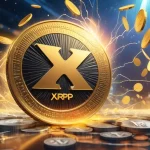JPMorgan’s Crypto Loan Plans Could Legitimize XRP—But Challenges Remain

JPMorgan’s Crypto Loan Plans Might Just Legitimize XRP—But Don’t Pop the Champagne Yet
Could a Wall Street titan like JPMorgan finally give XRP the credibility it’s been craving in the traditional finance world? Reports suggest that the banking giant, with a staggering $4.3 trillion in assets under management, is gearing up to offer crypto-backed loans by 2026, initially eyeing Bitcoin (BTC) and Ethereum (ETH), but potentially including XRP. Market expert Paul Barron calls this a game-changer, a bridge between the old-school banking system (TradFi) and the wild frontier of decentralized finance (DeFi). Let’s dig into what this means for XRP and the broader crypto landscape.
- Wall Street Endorsement: JPMorgan’s potential move to use crypto as loan collateral could validate XRP as a serious financial asset.
- Market Boost: With XRP’s market cap over $200 billion, ETF inflows could hit billions, though volatility persists.
- Regulatory Friction: Ripple faces pushback on its banking license bid, a hurdle to deeper TradFi integration.
JPMorgan’s Crypto Loan Gamble: A Shift in the Wind?
JPMorgan isn’t just dipping its toes into crypto; it’s considering a full-on dive with plans to offer loans backed by digital assets by 2026. For the uninitiated, using crypto as collateral means depositing your Bitcoin, Ethereum, or potentially XRP with a lender to secure a loan in traditional currency, like dollars. If you default, they claim your crypto. This isn’t a small pivot for a bank that’s historically been skeptical—CEO Jamie Dimon once famously called Bitcoin a “fraud.” Yet, with initiatives like their blockchain platform Onyx already in play, this loan move signals a thawing of icy attitudes. If the world’s largest bank starts treating crypto as a legitimate asset for lending, it’s not just news; it’s a tectonic shift for adoption.
Initially, the focus is on Bitcoin and Ethereum, the top dogs of the crypto world. But whispers suggest XRP could join the party, a point that has analysts like Paul Barron practically vibrating with optimism. He puts it bluntly:
“When the world’s largest bank recognizes crypto’s value as loan backing, then the market is witnessing the bridge between TradFi and DeFi.”
This isn’t mere hype. If JPMorgan, a symbol of centralized finance, embraces crypto collateral, it forces the suits on Wall Street to wake up—or risk being left in the dust. But let’s not kid ourselves; this is uncharted territory. Banks thrive on stability, and crypto’s notorious volatility could turn this experiment into a disaster if markets tank. Still, the mere consideration is a nod to blockchain’s potential to disrupt the status quo, a core tenet of what we champion here. For deeper insights into this evolving dynamic, check out this analysis on TradFi and DeFi integration.
Why XRP Could Be the Dark Horse in This Race
XRP, for those new to the game, isn’t Bitcoin or Ethereum. It’s a cryptocurrency tied to Ripple, a company laser-focused on revolutionizing cross-border payments. While Bitcoin is often hailed as digital gold—a store of value against fiat inflation—and Ethereum powers a sprawling ecosystem of decentralized apps via smart contracts, XRP’s mission is speed and cost-efficiency. Transactions settle in 3-5 seconds for under a penny, compared to Bitcoin’s 10+ minutes or traditional bank transfers via SWIFT that can take days and cost a fortune. This makes XRP a darling for financial institutions looking to streamline global money movement. Learn more about its underlying tech via the XRP Ledger overview.
Currently, XRP sits as the third-largest cryptocurrency by market cap, recently crossing $200 billion in total value of all coins in circulation—up from $146 billion earlier this year. To put that in perspective, it’s still behind Bitcoin’s trillion-dollar territory but a heavyweight nonetheless. If JPMorgan greenlights XRP as collateral, imagine conservative financial clients using it to secure multi-million-dollar loans. That’s not just a symbolic win; it’s a practical stamp of acceptance, potentially driving adoption through the roof among TradFi players who’ve long scoffed at crypto as speculative nonsense.
But here’s a devil’s advocate take: not everyone in crypto sees XRP as the hero. Bitcoin maximalists, who believe BTC is the only true decentralized currency, often criticize XRP for its close ties to Ripple, which controls a significant chunk of the token supply. They argue it’s barely decentralized, more like a corporate coin than a blockchain rebel. Fair point, but XRP’s niche in payments doesn’t directly clash with Bitcoin’s store-of-value role. Both can coexist, filling gaps in a financial revolution that’s still finding its footing. For a broader perspective on XRP’s standing, see this expert opinion on XRP’s legitimacy.
Market Dynamics: ETFs and the Volatility Rollercoaster
Beyond loans, there’s buzz about XRP exchange-traded funds (ETFs), which let investors gain exposure to the token without directly owning it—think of it as buying a stock tied to XRP’s value. JPMorgan predicts XRP ETFs could attract $4 billion to $8 billion in inflows in their first year if approved. Given the recent market cap surge, those numbers might be lowballing it. Such capital could skyrocket XRP’s visibility and price long-term, making it a staple in investment portfolios far beyond crypto nerds.
Yet, short-term, it’s a bumpy ride. As of now, XRP trades at $3.12, down over 10% in the last 24 hours per CoinMarketCap data. Why the dip despite bullish news? Crypto markets are a beast—speculative swings, profit-taking, and broader economic jitters often drown out fundamentals. This volatility is a glaring reminder that even with TradFi flirtations, digital assets remain a high-risk gamble. Still, for patient holders, the potential of institutional backing might outweigh these hiccups. Or will it? Only time will tell if this is a lasting trend or just another flash in the pan. Curious about public takes on this? Explore some community thoughts on XRP’s credibility with JPMorgan’s involvement.
Regulatory Quagmire: Ripple’s Uphill Battle
Ripple isn’t sitting idly by waiting for JPMorgan’s blessing. The company is pushing hard for deeper TradFi integration, including an application for a national trust bank charter in the U.S. This isn’t your typical bank license; it’s a federal designation allowing a firm to manage assets and provide fiduciary services under national oversight, without traditional lending or taking insured deposits. It’s a clever move to simplify regulatory headaches and expand XRP’s footprint in payment systems.
But here’s the rub: U.S. banking associations, like the American Bankers Association, are sounding alarms, urging the Office of the Comptroller of the Currency (OCC) to pump the brakes on approval. They’ve got a point—crypto’s wild price swings and hacking vulnerabilities (think Mt. Gox or FTX debacles) are a nightmare for risk-averse institutions. Plus, trust banks aren’t covered by FDIC insurance, raising thorny questions about consumer protection if things go south. Pro-XRP lawyer John Deaton is pushing for high-level intervention, but the outcome hangs in limbo. For more on this opposition, see the latest developments on Ripple’s banking license push.
This clash isn’t just Ripple’s problem; it mirrors the broader tension between centralized finance and decentralized innovation. Add in Ripple’s ongoing saga with the SEC over whether XRP is a security, and you’ve got a regulatory minefield. If the license bid fails, Ripple’s pitch to cautious institutions could falter, stunting XRP’s TradFi dreams. On the flip side, success might pave the way for other crypto firms like Circle or Fidelity Digital Assets, who are also chasing similar charters, to legitimize blockchain assets further.
TradFi Meets DeFi: Convergence or Collision Course?
Zooming out, JPMorgan’s crypto loan flirtation is a rare overlap of two worlds often at odds. Traditional finance, built on centuries of centralized control, naturally resists anything smelling of disruption. Decentralized finance, meanwhile, thrives on upending that very system with permissionless, transparent tech. This move feels like a handshake—proof these spheres can coexist. But let’s not get too cozy. Cybersecurity risks, market crashes, and regulatory uncertainty loom large. A single high-profile hack or a 50% crypto dump could send banks running for the hills.
Other developments add layers to this narrative. The recent GENIUS Act, signed into law, aims to regulate stablecoins—digital assets pegged to fiat like the dollar, unlike XRP. While not directly tied to Ripple’s token, it signals a shifting legislative landscape that could ease or complicate crypto’s TradFi integration. If banks like JPMorgan can implement safeguards—think cold storage for assets or loan insurance—confidence might grow. But skeptics warn this is a Pandora’s box. One TradFi analyst quipped off-record that crypto collateral could be “volatility waiting to detonate.” Harsh, but not entirely baseless given historical meltdowns. For academic perspectives, dive into research on XRP’s challenges and opportunities in TradFi adoption.
Future Outlook: 2026 and Beyond
Fast-forward to 2026: if JPMorgan rolls out these loans and includes XRP, we might see a domino effect. Other banks could follow, cementing XRP as TradFi’s go-to payment token. Pair that with a successful banking license for Ripple, and institutional adoption could hit warp speed. But this isn’t a guarantee—regulatory slaps or a major security breach could derail everything. And a word of caution: with hype comes scams. Fraudsters are already circling, peddling fake XRP loan schemes or phishing as “JPMorgan.” Stick to verified platforms and do your homework.
For the decentralization diehards, this moment is bittersweet. Sure, TradFi’s embrace boosts crypto’s reach, but it risks co-opting the very freedom blockchain stands for. Still, if banks adapt to decentralized principles instead of forcing crypto into old molds, the disruption we root for—true financial sovereignty—might just accelerate. Call it effective accelerationism in action, even if it’s messy. Stay updated on this evolving story with the latest news on JPMorgan’s crypto loan plans.
Key Questions and Takeaways on JPMorgan, XRP, and Crypto’s Future
- How Do JPMorgan Crypto Loans Impact XRP’s Credibility?
They offer a major endorsement, positioning XRP as a viable asset for traditional finance if included as collateral alongside Bitcoin and Ethereum. - What Could XRP ETFs Mean for Market Growth?
Predicted inflows of $4 billion to $8 billion in the first year could spike XRP’s price and mainstream appeal, pending regulatory nods. - What Challenges Does Ripple Face in TradFi Integration?
Opposition to its national banking license from U.S. banking groups, plus ongoing SEC scrutiny, poses significant roadblocks to XRP’s adoption. - Why Is XRP’s Price Dropping Amid Positive News?
Short-term volatility, common in crypto, drives the current 10% dip to $3.12, often unrelated to long-term fundamentals like institutional interest. - Can TradFi and DeFi Merge Through Moves Like This?
Potentially, as JPMorgan’s recognition bridges the gap, but regulatory hurdles and risk concerns could stall true convergence. - Should Bitcoin Maximalists Worry About XRP’s Rise?
Not directly—XRP’s payment focus complements Bitcoin’s store-of-value role, though debates over decentralization persist.
Stepping back, this saga encapsulates crypto’s relentless push for legitimacy. XRP, despite its baggage, offers a glimpse of blockchain solving real-world financial pain points—something Bitcoin or Ethereum don’t always prioritize. Yet, the regulatory gauntlet and market whims keep us grounded. If JPMorgan’s plans and Ripple’s ambitions pan out, we’re on the cusp of a paradigm overhaul. If not, it’s another chapter in crypto’s chaotic journey. Either way, could XRP’s TradFi embrace be the spark for mass adoption, or just a fleeting hype cycle in a merciless market? Chew on that as this space races forward.



